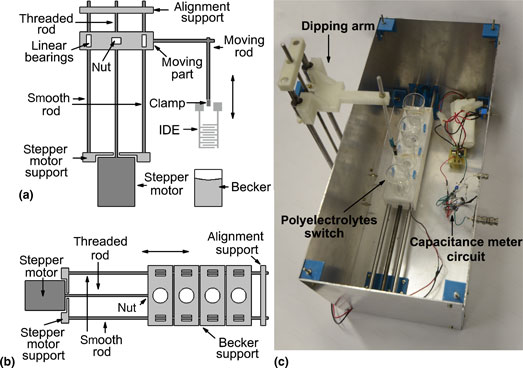Crossref Citations
This article has been cited by the following publications. This list is generated based on data provided by
Crossref.
Gaál, Gabriel
da Silva, Tatiana A.
Gaál, Vladimir
Hensel, Rafael C.
Amaral, Lucas R.
Rodrigues, Varlei
and
Riul, Antonio
2018.
3D Printed e-Tongue.
Frontiers in Chemistry,
Vol. 6,
Issue. ,
Hensel, Rafael C.
Moreira, Murilo
Riul, Antonio
Oliveira, Osvaldo N.
Rodrigues, Varlei
and
Hillenkamp, Matthias
2020.
Monitoring the dispersion and agglomeration of silver nanoparticles in polymer thin films using localized surface plasmons and Ferrell plasmons.
Applied Physics Letters,
Vol. 116,
Issue. 10,
L. Braunger, Maria
C. Hensel, Rafael
Gaál, Gabriel
J.M. Jimenez, Mawin
Rodrigues, Varlei
and
Riul Jr, Antonio
2020.
Multilayer Thin Films - Versatile Applications for Materials Engineering.
Hensel, Rafael C.
Pereira-da-Silva, Marcelo A.
Riul, Antonio
and
Rodrigues, Varlei
2020.
Dielectric Permittivity and Surface Charge Density in Layer-by-Layer Poly(diallyldimethylammonium chloride)/Poly(styrenesulfonate) Nanostructured Films: Implications for Biosensing.
ACS Applied Nano Materials,
Vol. 3,
Issue. 2,
p.
1749.
Ly, Kally C.S.
Jimenez, Mawin J.M.
Cucatti, Silvia
Volpati, Diogo
Pereira-da-Silva, Marcelo A.
Shimizu, Flavio M.
Almeida, Tiago P.
Rodrigues, Varlei
da Silva, Jose Alberto F.
Alvarez, Fernando
and
Riul, Antonio
2021.
Water enabled self-healing polymeric coating with reduced graphene oxide-reinforcement for sensors.
Sensors and Actuators Reports,
Vol. 3,
Issue. ,
p.
100059.
Gaál, Gabriel
M. Jimenez, Mawin J.
Alvarez, Fernando
Rodrigues, Varlei
and
Riul, Antonio
2021.
Influence of water on electrical and mechanical properties of self-assembled and self-healing PEM films.
Progress in Organic Coatings,
Vol. 150,
Issue. ,
p.
105980.
Hensel, Rafael C.
Braunger, Maria L.
Oliveira, Bruno
Shimizu, Flavio M.
Oliveira, Osvaldo N.
Hillenkamp, Matthias
Riul, Antonio
and
Rodrigues, Varlei
2021.
Controlled Incorporation of Silver Nanoparticles into Layer-by-Layer Polymer Films for Reusable Electronic Tongues.
ACS Applied Nano Materials,
Vol. 4,
Issue. 12,
p.
14231.
Hensel, Rafael C.
Gonçalves, Maria H.
Rodrigues, Kevin L.
Oiko, Vitor T.A.
Pimentel, Vinicius do L.
Pereira-da-Silva, Marcelo A.
Hillenkamp, Matthias
Riul Jr., Antonio
and
Rodrigues, Varlei
2021.
Monitoring and modeling the deposition of metal nanoparticles on surfaces by impedance.
Applied Surface Science,
Vol. 544,
Issue. ,
p.
148806.
Miyazaki, Celina M.
Shimizu, Flavio M.
and
Ferreira, Marystela
2022.
Functionalized Nanomaterial-Based Electrochemical Sensors.
p.
407.
